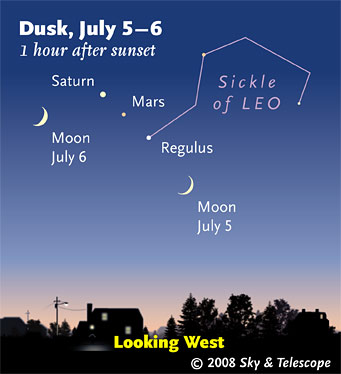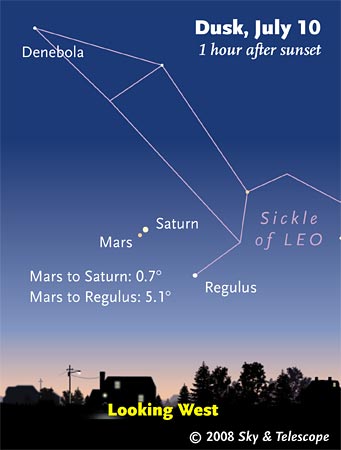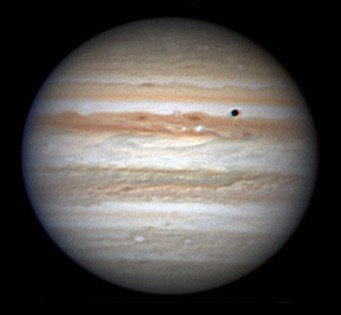Some daily events in the changing sky for July 3 – 12.
Comet Boattini is beginning to emerge low in the dawn. You'll need optical aid; it's only 5th or 6th magnitude — see our article and chart. The comet should be visible through mid-July. Here are pictures and a light curve (scroll down).
On July 6th, Brad Young of Tulsa, Oklahoma (latitude 36° north) found the comet "much brighter and bigger now than in spring. Easily found very low in the east at 4:30 a.m. CDT, with 12x60 binoculars on a dewy but clear morning. Approximately 6th magnitude and about 20 arcminute coma, no tail seen."

On the 5th and 6th, with the waxing Moon now on the scene, Mars is midway in its journey from Regulus to Saturn. (These scenes are drawn for the middle of North America. European observers: move each Moon symbol a quarter of the way toward the one for the previous date.)
Sky & Telescope diagram
Friday, July 4
- Going to the fireworks? As you're waiting while dusk deepens, show someone the brightest sky sights. Big Jupiter is rising low in the southeast. The orange-red supergiant star Antares sparkles higher in the south. Blue-white Vega is very high toward the east, and yellowish Arcturus is very high toward the southwest. And of course there's the ongoing Saturn-Mars-Regulus drama low in the western twilight.
- Jupiter's Great Red Spot should cross Jupiter's central meridian (the imaginary line down the center of the planet's disk from pole to pole) around 12:31 a.m. Saturday morning Eastern Daylight Time; 9:31 p.m. Friday evening Pacific Daylight Time. The "red" spot is currently pale orange. It should be visible for at least an hour before and after in a good 4-inch telescope if the atmospheric seeing is sharp and steady. A light blue or green filter helps.
For the times of all Red Spot transits this month, visible worldwide, see the July Sky & Telescope, page 66.
- Earth is at aphelion today, its farthest from the Sun for the year (only 1 part in 30 farther than at perihelion in January).
Saturday, July 5
- In twilight, look for the waxing crescent Moon to the lower right of Saturn, Mars, and Regulus, as shown above. The three points form a nice even lineup this evening and tomorrow evening — looking rather like Orion's Belt knocked out of place and out of season.
Sunday, July 6
- The thickening crescent Moon is now to the left of Saturn, Mars, and Regulus at dusk, as shown above.
Monday, July 7
- The tiny black shadow of Jupiter's moon Io crosses Jupiter's face from 9:25 to 11:41 p.m. Eastern Daylight Time, followed just 2 minutes behind (to its east) by Io itself — which is much harder to see against the planet's face. Io and its shadow appear so close together because Jupiter is just a day from opposition.
More about observing all sorts of Jupiter's-moons phenomena, and a timetable of all events for the month, are in the July Sky & Telescope starting on page 62.
- In the midst of this, Jupiter's Great Red Spot should transit around 10:00 p.m. EDT.
Tuesday, July 8
- Jupiter is at opposition tonight, opposite the Sun in our sky.
Wednesday, July 9
- First-quarter Moon this evening (exact at 12:35 a.m. Thursday morning Eastern Daylight Time).
- Jupiter's Great Red Spot should transit around 11:38 p.m. EDT.
Thursday, July 10
- Saturn and Mars are in conjunction, as shown below (actually, practically the same distance they were apart last night).
- Jupiter's big moon Ganymede slips behind the planet's western edge around 8:29 p.m. EDT. It reappears out of eclipse by Jupiter's shadow, barely off Jupiter's eastern edge, around 11:54 p.m. EDT.
Friday, July 11
- The Moon this evening shines between blue-white Spica, nearly two fist-widths at arm's length to the Moon's right, and orange-red Antares, even farther to the Moon's left.
- Jupiter's Great Red Spot should transit around 1:16 a.m. Saturday morning EDT; 10:16 p.m. Friday evening PDT.
Saturday, July 12
- Jupiter's Great Red Spot should transit around 9:07 p.m. EDT.

Mars is in conjunction with Saturn on the evenings of the 9th and the 10th.
Sky & Telescope diagram
Want to become a better amateur astronomer? Learn your way around the constellations. They're the key to locating everything fainter and deeper to hunt with binoculars or a telescope. For an easy-to-use constellation guide covering the whole evening sky, use the big monthly foldout map in each issue of Sky & Telescope, the essential magazine of astronomy. Or download our free Getting Started in Astronomy booklet (which only has bimonthly maps).
Once you get a telescope, to put it to good use you'll need a detailed, large-scale sky atlas (set of maps; the standards are Sky Atlas 2000.0 or the smaller Pocket Sky Atlas) and good deep-sky guidebooks (such as Sky Atlas 2000.0 Companion by Strong and Sinnott, the even more detailed Night Sky Observer's Guide by Kepple and Sanner, or the classic Burnham's Celestial Handbook). Read how to use them effectively.
More beginners' tips: "How to Start Right in Astronomy".
This Week's Planet Roundup

Lots is happening on Jupiter! In this first-rate stacked-video image from June 26th, Christopher Go caught the very beginning of a white outbreak (small, sharp bright spots) in the North Equatorial Belt (NEB, the dark red-brown belt just above center). The black dot is the shadow of Europa, with Europa itself following behind it (to the left; celestial east) by about a fifth of the planet's width.
Go also writes, "Note the dark oval at the NEBn. Note also the large white oval at the [edge of the] NEBn. The white bar in the [white] North Temperate Zone is fading, and note the dark formation on its southern edge. The southern polar area is notably dark." North is up (but remember that many telescopes show south up).
And on the other side of Jupiter, the third, newest, and littlest Red Spot has just been swallowed by the Great Red Spot (GRS). The GRS remains near System II longitude 121°.
Mercury (about magnitude –0.5) is having a modest apparition low in the dawn. Look for it above the east-northeast horizon about an hour before sunrise. Don't confuse it with Aldebaran well to its upper right, or Capella farther to its upper left. (To find your local sunrise time, and much else, make sure you've put your location and time zone into our online almanac. If you're on daylight saving time like most of North America, make sure the Daylight Saving Time box is checked.)
Venus is still very deep in the glow of sunset.
Mars and Saturn (magnitudes +1.7 and +0.8) are together in the west at dusk, as shown in the scenes above. They're in conjunction, 0.7° apart, on July 10th. They remain less than 2° apart from July 6th through 13th. And Regulus (magnitude +1.4) watches on from their lower right. Look early before they all sink too low and set!
Jupiter (magnitude –2.7, in Sagittarius) shines low in the southeast in twilight, left of the Sagittarius Teapot. Jupiter is highest in the south around midnight or 1 a.m. daylight saving time.
Uranus and Neptune (magnitudes 6 and 8, respectively, in Aquarius and Capricornus) are high in the southeast and south before the first light of dawn. Use our article and finder charts.
Pluto (magnitude 14.0, in northwestern Sagittarius) is highest in the south around 11 or midnight.
All descriptions that relate to your horizon or zenith — including the words up, down, right, and left — are written for the world's mid-northern latitudes. Descriptions that also depend on longitude (mainly Moon positions) are for North America. Eastern Daylight Time (EDT) equals Universal Time (UT, UTC, or GMT) minus 4 hours.
----------------------
To be sure to get the current Sky at a Glance, bookmark this URL:
http://SkyandTelescope.com/observing/ataglance?1=1
If pictures fail to load, refresh the page. If they still fail to load, change the 1 at the end of this URL to any other character and try again.
 0
0
Comments
You must be logged in to post a comment.